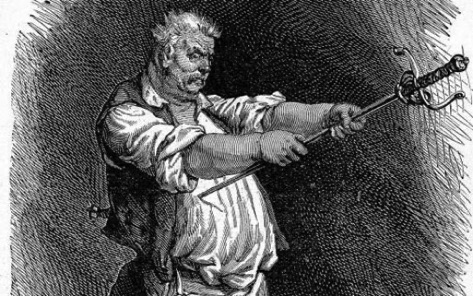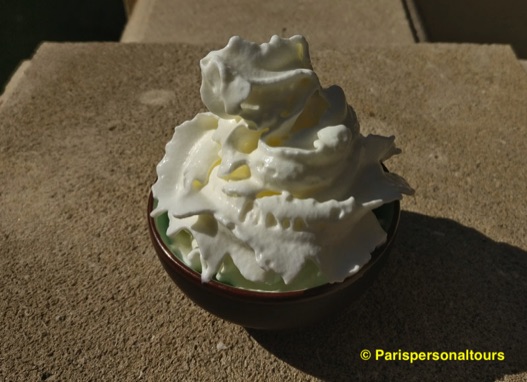
« Crème Chantilly » is the French name for whipped cream, and it’s often (but not always) a little bit sweeter than regular whipped cream.
Even though whipped cream was imported from Italy to France by Catherine of Medici when she married the future Henri II, the invention of the "Crème Chantilly" is often credited (without evidence) to the famous maître d’hôtel François Vatel. Vatel could have served it to Louis XIV either in 1661 at the chateau of Vaux-le-Vicomte while he was working for Nicolas Fouquet, or 10 years later in 1671 while in the service of the Prince of Condé at the Château de Chantilly, but the name Chantilly to designate whipped cream was only really used starting the mid-18th century.
Now, to tell you more about Vatel the man himself, Louis XIV in April 1671 announced that he would honour the Prince de Condé, his cousin, by visiting him at Chantilly. Not only was it a great honour to have the King visit as a guest, it was also vital for the Prince of Condé to make sure Louis would be pleased because the Prince had been kept away from the Court for years because he had been punished after he had dared rebel against his cousin’s authority in his youth during the Fronde.
As this royal visit put a lot of pressure over the Prince’s shoulders, the pressure fell also on Vatel as he only had two weeks to organise the meals for three days for six hundred nobles and several thousand additional people!
The first diner went almost to plan… but, since there were more guests than expected, there were was not quite enough food. Even though the Prince of Condé congratulated Vatel, the latter, having barely slept for the last two weeks, felt dishonoured.
As the next day was a Friday (and on top of that it was during Lent), they had to be served fish on that day. Fresh water fish was too common for the King thought Vatel, so he sent some buyers to several ports of Normandy (some 130 miles away from Chantilly) to bring the best saltwater fish. That Friday morning at 4 am he saw one buyer come back with only 2 baskets full of fish. « Is that all you could get? », « yes, Sir » the man replied… At 8 am, no other buyer had shown up. Vatel reportedly said « I cannot survive another dishonour ». He went back to his quarters, took his sword (The Prince de Condé, who was fond of Vatel, had given the right to carry a sword), stuck the sword’s handle in the door so that the sword stayed horizontal with the blade towards him, then he ran towards the blade so that he impaled himself in the heart with it! And, as Madame de Sévigné reports in one of her famous letters, « he had to do this three times, because the first two hadn't wounded him deeply enough to kill him ».
His body was discovered in a pool of blood when someone came to tell him of the arrival of the fish (which ironically came pouring in shortly afterwards…). And they didn't even eat the fish in the end! (to supposedly honor Vatel's memory).
Sad story, huh? Well, that’s just to remind you that life is no picnic, man...
Happy ending? Here is the best I can do for you: as Vatel committed suicide, he should have been denied burial on Christian grounds, but records show he was nevertheless buried at the local cemetery, which shows that the king and/or the Prince intervened. Otherwise, his body would have been a playing puppet for the locals because it was common procedure to punish the suicided dead bodies by pulling them around town, face down, and to throw them in the end in a garbage dump. So I guess we could say he was lucky in the end!
Vatel is to this day a symbol for whoever boasts to have a professional conscience, even though the great chefs all agree that he was to blame for losing his cool and lacking reactivity, which are primordial qualities of a great chef (but, then again, Vatel was not a Chef, he was just a Maitre d’).
You want to finish on a high note? Click here to see the trailer of Vatel (2000) with Gerard Depardieu playing Vatel and Uma Thurman playing an improbable lover of both Vatel and Louis the XIV. It’s historical fiction (based on true events though) but the movie is highly entertaining, the costumes are superb and the settings are amazing (no wonder: the movie was shot on location at Chantilly!).

